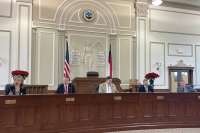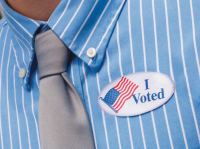Chattooga at the crossroads
A recurring debate between camps in the Chattooga River controversy is how many paddlers would actually come to the river.
The paddling community claims it won’t be very many, nor very often. They say they need at least two days of heavy rains to make paddling feasible — a condition that occurs only rarely, they said.
But opponents fear that won’t be the case.
“It’s going to be all the time. This won’t be just a rainy day deal,” said Kathy Kramer of Cashiers.
Part of an ongoing forest service study aimed to answer the evasive question — how many paddlers and how often.
“That’s a difficult task because boating isn’t allowed right now,” said Doug Whitaker, a consultant hired by the forest service to lead the study. “We are taking a shot at it because somebody has to.”
Related Items
Whitaker said he aimed high when estimating how many paddlers might flock to the river on a “good day” — immediately following at least two days of heavy rain. The number: 70 paddlers if these ideal conditions fell on a weekend when boaters could travel.
Joe Gatins, a spokesperson for Georgia Forest Watch, said the potential for 70 boaters in one day is a “startling statistic.”
“That’s way too many,” Gatins said. That many boaters on a single day would overwhelm the wilderness setting, Gatins said.
One compromise under discussion is a permit system that would limit the number of paddlers who could run the river on a single day. Gatins argued that would be a slippery slope.
“The history of the whitewater industry is they always want more,” Gatins said. If you let one boat in legally, the hordes will want to come. It’s the foot in the door syndrome.”
Paddlers don’t like the idea of a permit system either, arguing it is discriminatory since an unlimited number of hikers, campers and fishermen can traipse along the river any time they like.
In real life
The chances of 70 boaters in one day actually descending on the river would be few and far between, according to the study. The ideal conditions simply don’t roll around that often, according to historical rain data. Whitaker estimates there are six days a year at the most when the ideal river levels for paddling fall on the weekend. When the ideal river conditions fall on a weekend, the number of expected paddlers falls to only 20.
Whitaker pegged the total number of days when these ideal levels might occur at 34. But even that is misleading. Of those 34 days, the ideal levels might only last for part of a day, or happen in the middle of the night.
“It’s a very flashy river. When peaks happen, they happen very quickly and go away very quickly,” Whitaker said.
Catching a river at the right flow requires careful tracking and planning. Paddlers have to follow the weather, predict when the river will peak and adjust spur of the moment travel plans accordingly. Sometimes, the ideal levels occur during the week when paddlers can’t get there, or are difficult to predict ahead of time. These factors reduce the number of boaters that would actually show up for the ideal river levels, Whitaker said. That’s why the peak influx of boaters might be seen six days out of the year at best.
All Whitaker’s estimates ranged on the high side. While 34 was the maximum number of ideal paddling days Whitaker could imagine, the reality seems to be much lower. In the past 12 months, there were only 13 days that would have qualified as ideal river levels for paddling, Whitaker said.
Those ideal flows occur primarily in winter months, when other forms of recreation are down.
Less than ideal
Paddling is possible during less-than-ideal river levels, however. Whitaker estimated how many of these days there were, from simply “not ideal” to downright marginal. That amounted to another 77 days out of the year — for a total of 111 days out of the year when paddlers might feasibly be on the river.
Opponents to paddling were shocked by this number, since paddlers had insisted river levels suitable for paddling would only occur once in a blue moon. Whitaker’s number suggested paddling would be possible one-third of the year if you include the so-called marginal days.
But Whitaker’s numbers were merely intended to show the potential for boating, not what would actually happen. Out of those additional 77 days when boating was possible but not ideal, Whitaker estimated half would see no boating activity at all, and the other half would lure less than five boats a day.
Paddlers accused the opponents of manipulating the study data for their purposes.
“They make it sound like 77 days of the year there will be an influx of people, and it’s not going to happen,” said Robin Hitch of Cullowhee.
Paddlers agreed with one assessment by Whitaker: the first year or two the river is open to paddling there will be a rush on the river, but it would shortly die down.
Fishermen versus paddlers
The study was particularly focused on the potential overlap of fishing and paddling. Those two uses, more than others, have the potential for conflict since both occur in the water itself. On the bright side, while paddling becomes possible as river levels rise, fishing becomes less pleasant.
A study carried out over the winter attempted to quantify when paddling would become feasible and when fishing drops off. Following two days of heavy rains, a select group of paddlers made a run down the river and documented their experience. Meanwhile, a select group of fishermen were asked to fish the same days and document their experience.
The theory is that a compromise could be struck between fishermen and paddlers. Paddlers would only be on the river when fishermen weren’t there anyway.
That approach has angered hikers, backpackers, nature photographers, picnickers and the like.
“I’ve been very annoyed that this has boiled down to a fight between the anglers and boaters. That irritates me,” said Amy Chase of Cashiers.
The verdict of the trial run wasn’t too promising on the compromise front anyway. Paddlers concluded they could boat at much lower river levels than originally predicted. Fishermen claimed they could and would still be fishing during the high water levels preferred by boaters, despite describing the fishing experience as marginal.
The fishermen could have trumped up their experience during the trial run, insisting they would fish during high water to create the illusion of conflict, when in reality they probably wouldn’t chose to fish then. But Whitaker said he doesn’t think that happened, with the fishermen or boaters.
“We knew going in that both groups were packed with people with strong positions on how this river should be managed. It is possible that people gave us strategic answers, but I don’t think we got a dishonest conversation,” Whitaker said.












